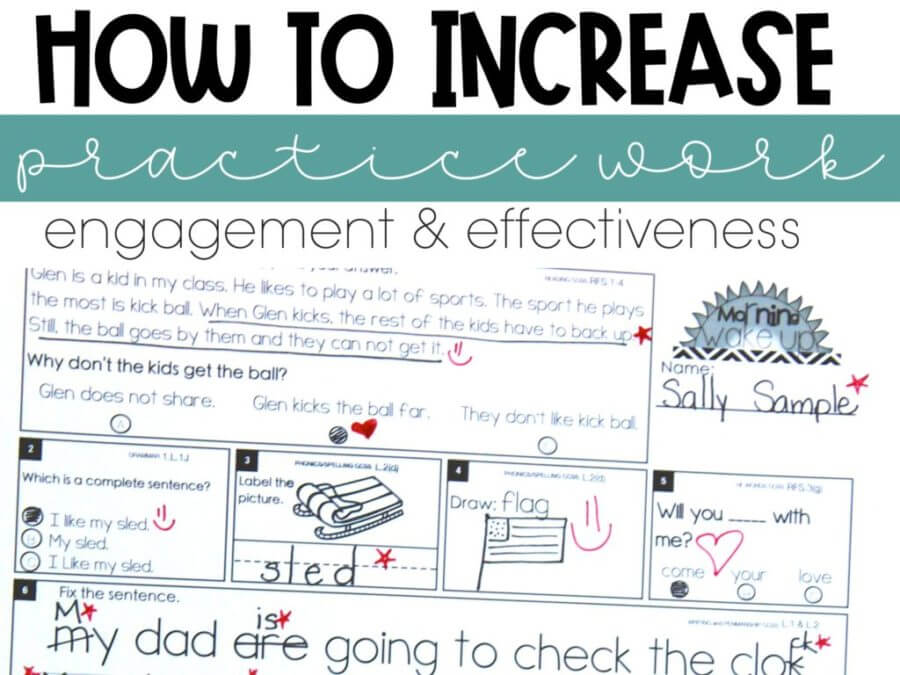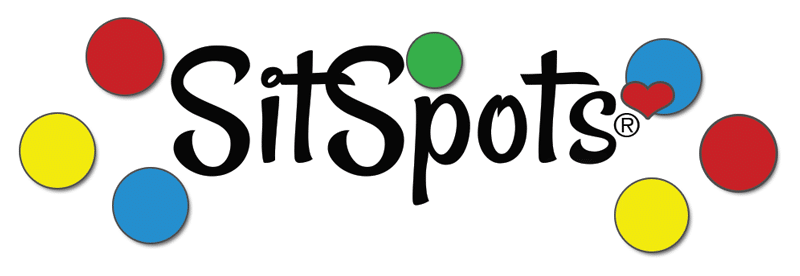Ever wonder how to increase student engagement with practice work? Are you fearful that some of the practice or independent work you give your kiddos is often just “busy work”? I get it. Here’s how to kick that fear to the curb!
Recently a teacher emailed me asking a few questions about my digital plans I post each week. One of her questions was about my Morning Wake-Up block. My morning work time.
Here’s a glimpse of what she was asking about.

She asked how I stretched my Morning Wake-Up time to 30 minutes. And what was I doing while the kids were working on this?
Legitimate question.
The Art of Slowing Down
It gives me an opportunity to share with you one of the greatest things I’ve learned in all my years of teaching.
s.l.o.w. d.o.w.n.
I don’t mean work slowly. What I mean is – stop making the goal to get through your stack of work you scheduled for the day. Make everything meaningful instead.
It wasn’t an easy shift.
I’m a task person. I like to check things off. Get things done. Move on.
But that is definitely NOT the way to teach. Thorough understanding doesn’t occur that way. No, I don’t mean throw out your schedule! That’s just crazy talk!!! Just make room in it for better teaching.
Giving myself permission (and sometimes simply forcing myself) to SLOW DOWN and wring every speck of learning out of each thing we do in class was a fabulous change for me. During my first few years of teaching, I always stressed about getting everything done and not “falling behind”.
One of the biggest and best “shifts” I made in this area was in correcting work. This shift tremendously student engagement.
Happiness found in a RED PEN
I rarely grade things on my own and pass them back. In my class, my kiddos hear a lot of…
Ok, grab your red pens and we’ll go over this.
In the first weeks of school, we go over the rules about the red pens. We talk at length about how to grade/go over your own work. The kids know that skipping ahead, marking something correct when it is actually wrong and just needs to be fixed, will result in a moved tile and a paper that is thrown away. If they get something wrong, they know it is absolutely no big deal. However, it is a HUGE deal if they don’t fix it when we go over it.
This seems SUPER extreme. And it is. BUT, it only needs to happen once (if ever) and everyone gets it. Initially, the kiddos are nervous about getting something wrong. They are scared to mark up their paper with a pen to fix it. But they quickly realize that I do not look at these fixes as a problem. It’s a good thing. We LEARN FROM MISTAKES. All of us do.
Morning Wake-Up – the PERFECT Way to Wake-Up that Schema!
Morning Wake Up is a morning work review sheet that we do each day. I’ve had it bound into books that the kids keep in their desks.

Most of the kids finish the assigned page each day in about 15 minutes. Those who finish before the others quietly read their library books while waiting for their classmates. For the Kinder version, I recommend having the early finishers color the pictures. During those 15 minutes – I get a few things done. I’ll also sip coffee and try to wake up my own brain cells. 🙂
Here’s one of the pages. Keep in mind that the question content/standards vary a bit throughout the year, but the format remains consistent.

Because the pages change only slightly each time, the kids quickly learn how to complete the pages on their own. They do this with minimal initial instruction.
This detail is super important to me for most practice work. I want the kiddos focused on the result and skill – not the procedure of the “worksheet”.
Once completed, our morning wake up pages look like this:

The Importance of “WHY”
After my students have completed the page I say…
Ok kiddos, let’s go over this.
They all put away their books and pencils and grab their red pens.
But this is the important part. I don’t just tell them the answers and have them mark them right and fix any errors. Each and every day we do a little lesson on each question. I consider it a time where they teach me. Their job is to explain to me why their answer is correct and I do a lot of asking why. A LOT OF ASKING WHY.
Text-Dependent Evidence
The first question is my favorite part. It requires some common sense that a few of them definitely need to practice developing. Often they know the answer but aren’t sure how to articulate how they know it. Finding evidence is new and saying “because” without anything to back that up is often a natural habit.

I begin the correcting of this problem with questions like:
Is it possible the kids don’t like to play kick ball?
Sure, some kids don’t. But did the text talk about whether they liked it or not?
Is it possible that Glen doesn’t like to share?
Absolutely! We don’t know this kid, Glen. The author doesn’t tell us about his sharing habits.
Did the author say Glen kicked the ball far?
No, but there is evidence that Glen did kick it far.
They must give me the reason WHY they chose choice B. This lends VERY well to Common Core. Students must be able to decipher between good or reasonable choices and select what is BEST. The kiddos know that the main idea of this question is to underline the evidence. Choosing the correct multiple choice answer is not the focus. As the year progresses, the answers to questions in this section get more complex and demand more attention to detail.
This section also builds in reading complexity. We begin the year with one sentence to read and answer a question about. The sentences only contain words that follow the phonic rules and sight words 1st graders would have learned at the point in the year. It is absolute practice relative to what they’ve already learned.
Explain What Wrong Answers Are Lacking

For questions like this, I always ask things like “Why isn’t C the correct answer?” Or, “What’s wrong with B? It starts with a capital.”
Having kiddos explain why something is wrong allows them to engage higher-level thinking. Additionally, it allows them to demonstrate a more thorough knowledge of a concept. When they CAN’T explain it – I know we have another opportunity for a well-needed lesson.

Going BEYOND Phonic Rule Identification
That type of question allows us to discuss WHY the name of this picture follows a phonic or spelling rule we’ve learned about.
The same for this type of question…

I LOVE to have my little peeps explain to me the phonic rule or spelling pattern found in words, rather than ask them to spell or read it correctly. AGAIN… the more they can explain, the higher-level their thinking and the greater rules are embedded into their schema.
Give Me an Explanation
With the following question types, I review DAILY how to read each choice within the sentence regardless of whether or not they think they know the right answer right away. This helps them get used to “hearing” what is wrong with some answer choices and makes it easier to find correct answers when the complete the sentence type question is more challenging. I also ask things like:
I’ve never seen that word that starts with a y before. How do I figure out what it says?
This provides the kiddos with another opportunity to demonstrate their knowledge about sounding out, similar words, chunking and all of the other decoding skills we discuss.

Editing, sentence construction, and penmanship are something we work on constantly throughout each day. This task may have errors in punctuation, capitals, grammar, and/or spelling. Their job is to find it all – fix it – and then write it correctly using GORGEOUS PRINTING that must include properly formed letters that use the lines and words that have spaces between them.

They get a lot of opportunities to put happy marks (whatever they want to mark their paper with when grading… it could be happy faces, stars, hearts, etc) on their paper. They get a “point” for each and everything they fix and do properly – including a HUGE happy mark for gorgeous printing. 🙂 Can you tell printing is a pet peeve of mine. haha
Digging Deeper with Math
This sample of math is pretty straight forward. The kiddos know they need to show the complete number sentence for how they found their answers. For example on problem number 7, it would not be acceptable to only write 3.

Correcting for Meaning
So in the end, a corrected paper will look something like the one below. Any corrections they needed to make would be made with their red pen. For the most part, the mistakes rarely get repeated, because those little peeps DO learn from their mistakes. They take tremendous pride in that!

Throughout the time we are “going over” our paper I walk around the classroom and monitor their happy marks. They’ve learned my expectation is to try your best, fix your mistakes, ask questions if you don’t understand why you got something wrong.
We talk at length about the importance of learning from your mistakes, explaining your thinking and using what you know to answer questions. In other words – be ENGAGED.
And, frankly, they are amazing at it.
Encouraging THINKERS!
When I first started teaching, it was hard for me to see morning work as anything other than a COLOSSAL WASTE OF TIME. After all, it is review, it should go quick. But I realized that this review was a perfect opportunity for the kiddos to completely consume these concepts. Eat them up, spit them back out, know them upside down, sideways and backward. AND it helps me identify who knows the concept and who doesn’t while allowing me to immediately address the issue.
Realizing I had to make a shift in thinking in order to ensure what we did in class was as meaningful and effective as could be definitely made me a better teacher and definitely helped my students become amazingly successful thinkers! This technique is something I do all day long on most things we do “independently” unless I plan to use the work as a formal assessment.
The result is increased student engagement, learning and effective time use!
Slow Down and Dig Deeper
If you feel that stress of getting through it all, I greatly recommend you try telling yourself to slow down and just spend a day doing a lot of asking why. Have your kiddos teach you what they know. You will learn a lot about what they don’t know and what you thought they “got” but really didn’t. If you are nervous about slowing down and letting some things on the plan go – I promise you’ll change your mind after shifting gears for a couple of days. Once you see the shift within your student’s knowledge gain you will be so happy you took the time. Worried your higher-level students will be bored? Don’t be. They absolutely LOVE being able to teach a concept back to you. All of my kiddos are seriously incredibly engaged during these “grading” times.
Beyond these engagement benefits – there is the HUGE plus of teacher time benefit. Your day is spent in engaging lessons and review. Deep thinking. Not GRADING PAPERS. A teacher grading a paper and sending it home does little to nothing to help students become better learners.
It is essential to ensure that busy or review work into something that is engaging, effective and not something that YOU need to grade.
Students need every opportunity to improve, gain mastery and build ownership of their learning! Teach smarter not harder. I use this technique all day, every day!
It absolutely increases practice work engagement and effectiveness!
So… that’s why Morning Wake-Up takes 30 minutes. 🙂
Check out this post for Morning Wake Up for K, 1st and 2nd!
Grab a FREE SAMPLE of Morning Wake Up
Enjoy your day peeps!






